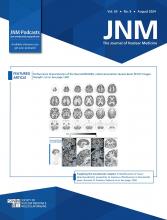A 38-y-old man with mixed, nonseminomatous germ cell carcinoma metastatic to the lung, liver, and retroperitoneal lymph nodes was treated with left orchiectomy and 4 cycles of cisplatin, etoposide, and ifosfamide. CT performed 3 d after the end of the last cycle showed significant improvement but persistent liver and retroperitoneal lesions. A liver lesion biopsy performed 1 mo after chemotherapy was negative for residual tumor (fibrosis, necrosis, and abundant hemosiderin-laden macrophages, consistent with treatment effect). An [18F]FDG PET/CT scan performed 80 d after chemotherapy (Fig. 1) demonstrated uptake in some of the residual liver lesions (SUVmax, 4.8–5.8), suggesting potential residual active disease, and there was moderate uptake in the retroperitoneal lymph nodes (SUVmax, 3.2). A PET/CT scan with a fibroblast activation protein (FAP) inhibitor (FAPI), [68Ga]Ga-FAPI-46, was performed as part of an exploratory study, NCT04459273 (Fig. 1), 97 d after the last chemotherapy cycle. The liver lesions exhibited heterogeneous uptake (SUVmax, 2.6–4.9), and the retroperitoneal lymph nodes had moderate uptake (SUVmax, 3.2). Retroperitoneal lymphadenectomy, partial left lateral liver segmentectomy, and multiple wedge biopsies of liver lesions, performed 9 d after the [68Ga]Ga-FAPI-46 PET scan, showed necrotic tumor nodules with variable stages of fibrosis and no viable germ cell tumor. Eighteen months after surgery, the patient did not show any signs of disease progression, and abdominal CT demonstrated a decrease in the size of the liver lesions.
[18F]FDG PET and [68Ga]Ga-FAPI-46 PET maximum-intensity projections showing liver lesions and retroperitoneal lymph nodes (arrows). Hypoenhancing liver lesions in segments VII and III measuring 35 × 47 mm and 13 × 19 mm had increased [68Ga]Ga-FAPI-46 uptake (SUVmax, 4.9 and 4.4) and [18F]FDG uptake (SUVmax, 4.8 and 5.8). Segment VIII lesion measuring 27 × 36 mm had mild peripheral rim of [68Ga]Ga-FAPI-46 uptake (SUVmax, 2.6) and no [18F]FDG uptake. Residual retroperitoneal lymph node measuring 14 × 18 mm presented moderate [68Ga]Ga-FAPI-46 uptake (SUVmax, 3.2) and [18F]FDG uptake (SUVmax, 3.2).
FAP-targeted PET imaging is promising in malignancies associated with a high content of FAP-expressing cancer-associated fibroblasts. Some reports in the literature describe the potential use of [68Ga]Ga-FAPI PET for therapy response assessment for a variety of cancers (1–5). However, FAP is also expressed by normal activated fibroblasts present in multiple fibroinflammatory conditions, remodeling processes, and wound healing. Nevertheless, posttreatment cancer cell apoptosis may not necessarily affect cancer-associated fibroblasts or decrease fibroblast activation. The ability of FAP tracer to assess therapy response is yet to be determined.
This case illustrates that postchemotherapy fibronecrotic tissue in nonseminomatous germ cell tumor can demonstrate [68Ga]Ga-FAPI PET uptake and that caution is needed in the interpretation of posttherapy residual lesions.
DISCLOSURE
No potential conflict of interest relevant to this article was reported.
Footnotes
Published online Apr. 25, 2024.
- © 2024 by the Society of Nuclear Medicine and Molecular Imaging.
REFERENCES
- Received for publication February 14, 2024.
- Accepted for publication March 25, 2024.








